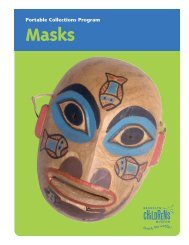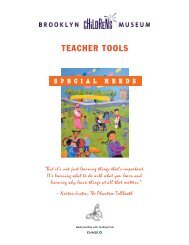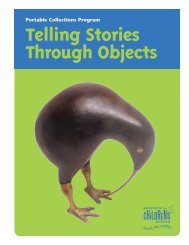African Textiles - Brooklyn Children's Museum
African Textiles - Brooklyn Children's Museum
African Textiles - Brooklyn Children's Museum
Create successful ePaper yourself
Turn your PDF publications into a flip-book with our unique Google optimized e-Paper software.
Activities to do with your studentsBefore You BeginTry to recruit volunteers to help you with this activity.Volunteers can be used to assist students in tying and dyeingfabric and setting up workstations.Set up four tying workstations. Each station should includerubber bands and marbles/rubber balls.Set up two dyeing workstations. Each station should beequipped with two large plastic tubs filled with dye (see boxfor instructions). Have latex gloves and smocks available forstudents.Set up two rinsing workstations. Each station should beequipped with two large plastic tubs filled with water. Have latexgloves and smocks available for students.If possible, try to do this outdoors as dyeing can be messy. This maybe easier than protecting floors and tabletops with plastic sheets.You will need a place for drying the t-shirts. This may be outsideif it’s a nice day or somewhere inside your classroom. A strongcord tied across the classroom is a simple solution.What To Do1. Allow students to examine the various adire samples and guidethem in drawing conclusions as to how the designs might havebeen made: stitched, tied, or painted? Using the objects, introduceadire cloth and the various resist-dye techniques that can beused to accomplish the different designs.2. Hand out and review the Adire Designs sheet and review theinstructions on how to create different tie-dye designs.Demonstrate how each effect is achieved. Hold up the clothnapkin and ask students to refer to their Adire Designs sheetto guess how the design was created.3. Make sure each workstation is equipped with rubber bands andmarbles/balls. Before beginning, ask students to write theirname in permanent marker on the collar or back of their t-shirt.Encourage students to design their own adire using the materialsprovided and the design template as a guide.4. When students have finished tying fabric, bring the class over tothe dyeing station (invite parent volunteers to help). Have a fewcontainers ready: two containers filled with dye (follow boxdirections) and two filled with clear water. If you have to do thisinside, make sure to protect tabletops and floors with plasticsheeting.7. Wearing smocks and latex gloves, have students put theirt-shirts in the dye baths. Explain to them the longer the t-shirtstays in the darker their cloth will be.<strong>African</strong> <strong>Textiles</strong> | 22








